Diplomatic Corps Official's Dagger
CATEGORY: Version
SKU: 34.GOR.04.01.001.000
Estimated market value:
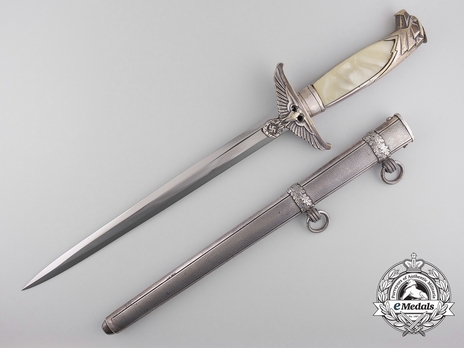
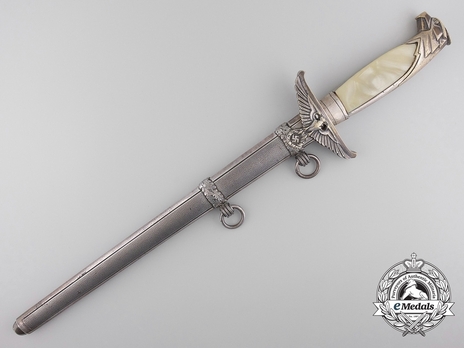
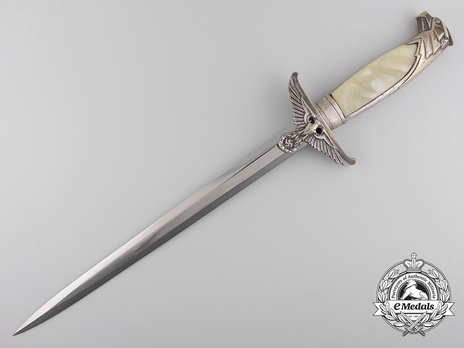
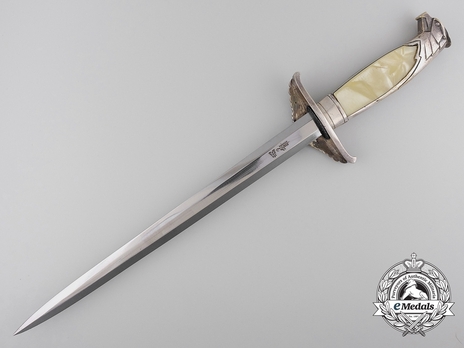
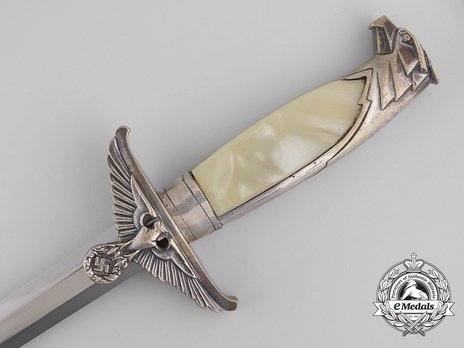
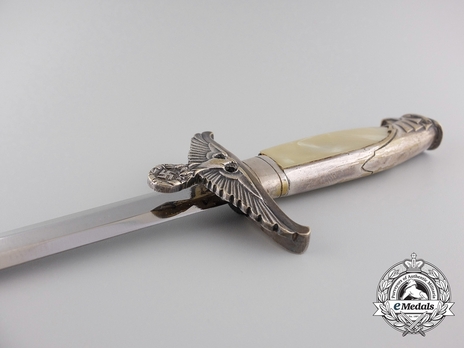
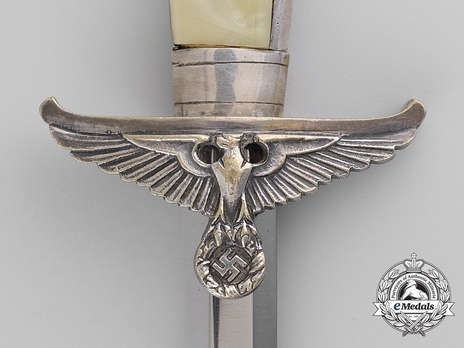
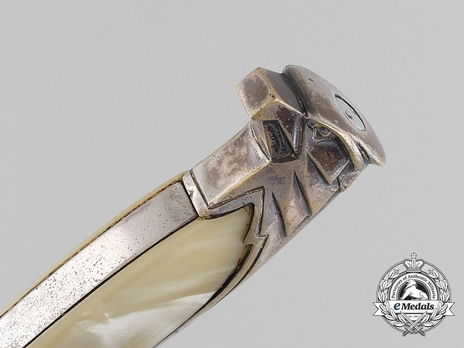
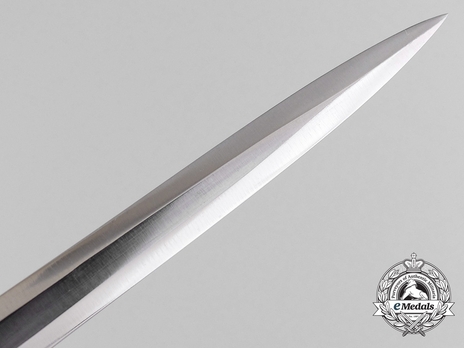
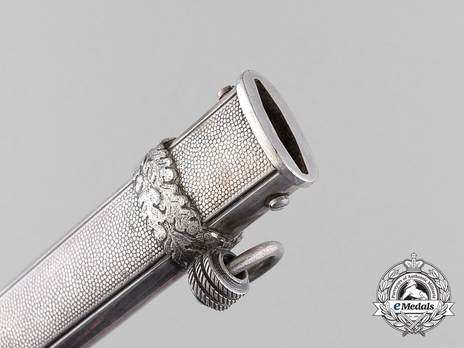
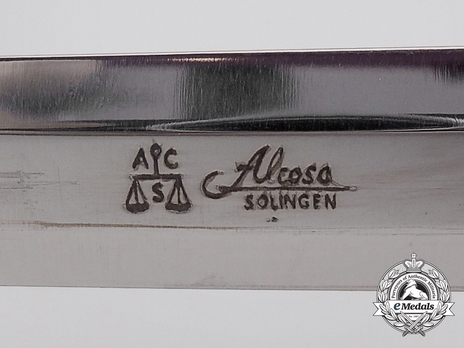
Estimated market value:
This Alcoso made Government Official's Dagger is in excellent overall condition; it retains all of its silvering throughout the hilt and scabbard, which is now nicely toned, with light pleasing patina; the spanner nut has same patina as the rest of the handle, and careful indication would suggest that it may have been out once or twice long time ago; it is a great condition. The eagle head pommel is in excellent condition, without scratches or damage; head is very well defined and in excellent condition overall; the feathering below the bird's head is crisp and well defined; the accent lines which run along the border of the lower pommel and backstrap are deeply engraved and well defined. The ferrule below has the traditional dual accent lines.The crossguard is a well defined, nice example, featuring the eagle head (looks to the viewer's left) with outstretched wings; the crossguard is dark toned, and typical Alcoso. The grip plates are made of (simulating mother-of-pearl) celluloid, of creamy, yellowish/golden color, well matched, without damages or chipping – in excellent condition. The scabbard of this fine dagger is straight throughout, dark toned, without dents or damages; the overlapping oak leaf bands and acorns are finely detail, while the eyelets have the triple serrated surfaces, crisp and problem free; the throat is retained by two head side screws which are unturned. The blade of this example is bright and shiny, rust free, and retains nearly 100% cross-graining; on the reverse ricasso is the trademark which consists of the scales, and "ALCOSO SOLINGEN". The original, blue leather blade washer is in place. An excellent example of the government official dagger by “Alcoso”, slightly worn, and in extremely fine condition overall.
The Diplomatic Corps was made up of officials (civil servants) of the Foreign Ministry. This ministry was taken over in 1938 by newly appointed Foreign Minister Joachim von Ribbentrop who, for the first time, introduced specific Diplomatic Corps uniforms. Prior to 1938, there had been no defined uniforms for members of the Foreign Office.
Prior to the war, the Foreign Ministry was heavily involved in the annexation of Austria and the Sudetenland. During the war, some conquered territory, especially in Poland, was incorporated into the German Reich, while other territory was merely occupied. These countries, while officially still independent, were in reality administered by German officials of the Diplomatic Corps, and in some cases also German-approved puppet governments.
It is important to remember that the officials who served within the borders of the German Reich weren’t of course part of the Foreign Ministry, but rather of the Ministry of the Interior. However, the officials of both these ministries wore nearly identical uniforms.
Officials of the Diplomatic Corps were distinguished by rank as well as their educational level. The latter determined which kind of “Laufbahn” (career) an individual was able to choose. The “Höherer Dienst” (Higher Career) required a university degree, the “Gehobener Dienst” (Elevated Career) required a college degree, the “Mittlerer Dienst” (Middle Career) required a highschool degree, and the “Einfacher Dienst” (Lower Career) required a grade school education, to put it in a simplified way. Additionally, the Higher and Elevated Careers included several different pay groups.
Uniforms for the Diplomatic Corps were first introduced in 1938. They underwent near continuous modification between then and 1943.
The Diplomatic Official’s Dagger was first introduced during Hitler’s state visit to Italy in May 1938. This dagger was only permitted for wear by diplomatic officials.
The handle of the dagger is made up of the pommel, the grip, and the crossguard. The pommel is in the form of a stylized eagle facing to the viewer’s left. The grip is composed of mother-of-pearl, or imitation mother-of-pearl (celluloid). The crossguard features a right-facing national eagle emblem; unlike the Diplomatic Official’s Sword, there are rare instances in which the dagger’s crossguard eagle faces left.
The sword is composed of nickel-plated steel, and the reverse ricasso displays the manufacturer mark/logo.
The scabbard is made from pebbled silvered iron with two silvered fittings, one at the scabbard throat (throat piece/locket) and the other at the bottom (toe piece/chape). Both fittings feature a band with oak leaves and acorn designs and a suspension ring. The suspension ring facilitates the dagger’s attachment to the dagger hangers.
The double strap dagger hangers are composed of a silver-coloured metallic (aluminum) cover sewn onto a navy blue or black velvet base and have silver (silvered) or gold (gilt) coloured buckles and hooks, depending on the rank and pay group of the wearer.
The portapee/sword knot is generally made from metallic silver-coloured (aluminum) bullion wire.

Comments
Sign in to comment and reply.


Scroll Top